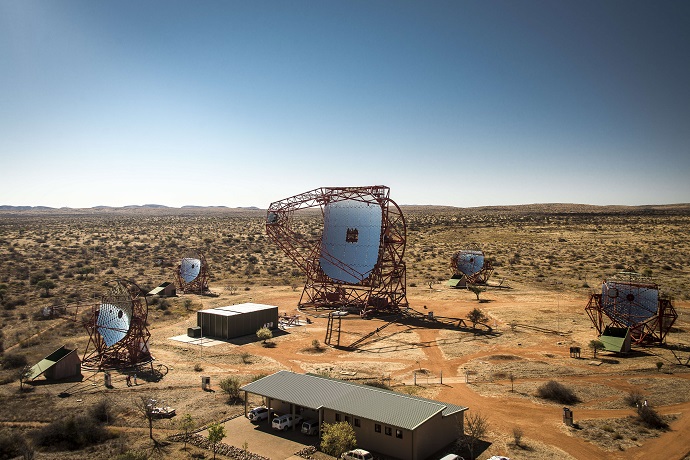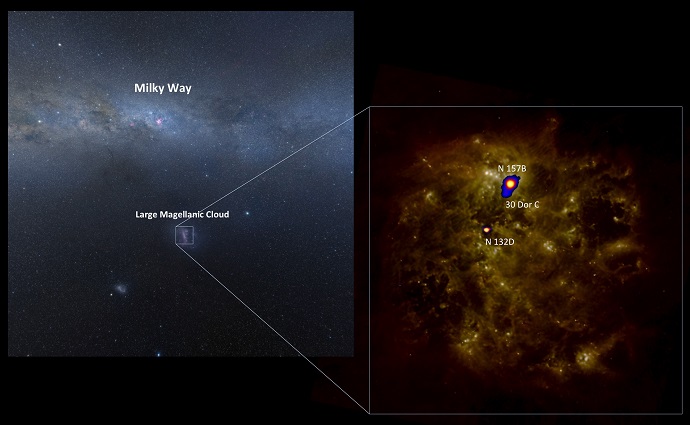2015/01/22
Once again, the High Energy Stereoscopic System, H.E.S.S., has demonstrated its discovery potential. In the Large Magellanic Cloud, it discovered most luminous very high-energy gamma-ray sources: three objects of different type, namely the pulsar driving wind nebula of the most powerful observed pulsar ever, a most powerful supernova remnant, and a so-called superbubble – a bowl-shaped formation 270 light years in diameter blown by multiple supernovae and stars. This is the first time that a population of stellar-type gamma-ray sources has been detected in an external galaxy, at these highest gamma-ray energies. The superbubble represents the first documented kind of a new source class in very high-energy gamma-rays. The H.E.S.S. Collaboration presents its results in the latest edition of the science journal “Science”.
“For a total of 210 hours of measuring time with the H.E.S.S. telescopes we could resolve three fundamentally different sources of high-energy gamma-rays”, said H.E.S.S. spokesperson Prof. Dr Christian Stegmann (DESY). “This shows the huge discovery potential behind the use of combined reflecting telescopes.
Cosmic particle accelerators, mostly supernova remnants and pulsar wind nebulas, i.e. end products of massive stars, are sources of intensive high-energy gamma-rays. They accelerate charged particles to extremely high velocities. When these particles hit the gas or light that surrounds them, gamma-rays are emitted. Most energetic gamma-rays from the cosmos can be observed with extremely sensitive measuring instruments from the surface of the Earth. Entering into the atmosphere they cause cascades of charged secondary particles, so-called particle showers. These emit extreme short, bluish light flashes (Cherenkov light) , which can be detected with big mirror telescopes and rapid light sensors.

Infrared picture of the Large Magellanic Cloud with superimposed H.E.S.S. sky maps
(Picture: © H.E.S.S. Collaboration, infrared: M. Braun et al. (1997), http://dirty.as.arizona.edu/~kgordon/research/mc/mc.html)
The Large Magellanic Cloud (LMC) is a dwarf satellite galaxy of our Milky Way, located about 170 000 light years away. New stars are constantly being formed in it and it harbours numerous massive stellar clusters. The rate by which the new massive stars are formed and explode as supernovae at the end of their lifetime is, relative to its stellar mass, five times higher in the LMC than in the Milky Way. That is one of the reasons why the scientists of the H.E.S.S. Collaboration study these cosmic objects intensively. They examine their most energetic gamma-rays in order to understand the mechanism of particle acceleration in young supernova explosions.
For a total of 210 hours astroparticle physicists aligned the H.E.S.S. telescope on the largest star-forming region within the LMC: the Tarantula Nebula. For the first time they could map several sources of highest energetic gamma-rays in a galaxy outside the Milky Way at the same time and spatially resolved; on top of that they studied three different and extreme high-energetic objects.
The so-called superbubble “30 Dor C” is the largest known X-ray-emitting shell and appears to have been created by several supernovae and strong stellar winds. Until now, it was unclear if superbubbles produce cosmic rays in addition to supernovae remnants. The H.E.S.S. results demonstrate that the bubble is a source, and filled by highly energetic particles. This means that 30 Dor C represents the first proven kind of a new class in very high-energy gamma-ray sources.
The pulsar driving wind nebula observed with the H.E.S.S. telescopes bears the number N 157B. Pulsars are highly magnetised, fast rotating neutron stars which emit a wind of ultra-relativistic particles forming a nebula. The best known example is the Crab Nebula, one of the brightest sources in the high-energy gamma-ray sky. The pulsar of the nebular N 157B in many respects is a twin of the very strong Crab pulsar in our Galaxy. However, N 157B is ten orders of magnitude brighter than the Crab Nebular in the very high-energy gamma-rays. The reasons for this is the lower magnetic field in N 157B and the intense starlight from neighbouring star-forming regions, which both promote the generation of high-energy gamma-rays.
The supernova remnant N 132D is already known as a bright object in the radio and infrared bands. The recent H.E.S.S. measurements show that this object appears to be also one of the oldest – and strongest – supernova remnants glowing in very high-energy gamma-ray light. It is between 2500 and 6000 years old and still outshines the strongest supernova remnant in the Milky Way, although models predict that the expansion of the supernova should be so slow that it is no longer an efficient particle accelerator. “The results confirm the assumption from earlier observations with H.E.S.S. that supernova remnants can be much more luminescent that thought before,” says DESY researcher Stefan Ohm, who made significant contributions to the interpretation and modeling of the LMC data. For measuring such close neighbouring objects scientist have significantly improved the methods for the accuracy of the resolution of the direction where the gamma-rays come from. Future planned experiments in astroparticle physics will benefit. “Just imagine what we could achieve with the more sensitive Cherenkov Telescope Array (CTA) in a few years!” says Ohm.
An electronic upgrade presently developed in Zeuthen will boost the performance of the H.E.S.S. telescope system from 2016 on. For the further future the scientists of the Cherenkov Telescope Array (CTA) plan that as of 2020 the LMC shall provide more sensitive and higher resolving gamma-light images. This galaxy, as the most important object of observation, is high up on the agenda of CTA scientists.

The H.E.S.S. mirror telescopes in Namibia, recently complemented with a 28-metre mirror
(Picture: © Christian Föhr/ H.E.S.S. Collaboration, 2012)
Original publication
"The exceptionally powerful TeV gamma-ray emitters in the Large Magellanic Cloud", by the H.E.S.S. Collaboration, DOI: 10.11.26/science.1261313
The High Energy Stereoscopic System
The H.E.S.S. collaboration teams up scientists from Germany, France, Great Britain, Namibia, South Africa, Ireland, Armenia, Poland, Australia, Austria, Holland and Sweden, supported by their respective funding agencies and institutions.
The H.E.S.S. mirror telescopes are situated in Namibia in the southwest of Africa. This system, consisting of four 13-metre diameter telescopes was recently complemented with the 28-metre H.E.S.S. II telescope and is one of the most sensitive detectors of very high-energy gamma rays. When absorbed in the Earth’s atmosphere they create a short-lived shower of particles. The H.E.S.S. telescopes detect the faint bluish flashes which these particle showers emit (named Cherenkov-Light, lasting a few billionths of a second), collecting the light with big mirrors which reflect it onto extremely sensitive cameras. Each image gives the position on the sky of a single gamma-ray photon, and the amount of light collected corresponds to its energy. Building up the images photon by photon allows H.E.S.S. to create maps of astronomical objects as they appear in gamma rays.
The H.E.S.S. telescopes have been operating since late 2002; in September 2012 H.E.S.S. celebrated the first decade of operation, within which the telescopes had recorded 9415 hours of observation, and detected 6361 million air shower events. H.E.S.S. has discovered the majority of the about 150 known cosmic objects emitting highest-energy gamma-rays. In 2006 the H.E.S.S. team was awarded the Descartes Prize of the European Commission and in 2010 the Rossi Prize of the American Astronomical Society. In 2009 a study listed H.E.S.S. among the top 10 observatories worldwide.















